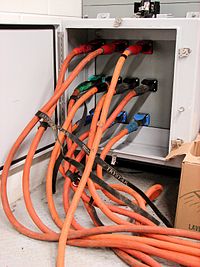Camlock (electrical)
A camlock, or also cam lock and Cam-Lok, is an interchangeable single-pole electrical connector often used in temporary electrical power production and distribution predominantly used in North America.[1] Originally a trade name as Cam-Lok, it is now a generic term.[2]
The most common form is the 16 series, rated at 400 amperes with 105 °C terminations. Also in common use is the 15 series (mini-cam), rated at 150 amperes. A larger version is made denoted as the 17 series with ratings up to 760 A. A ball nose version and a longer nose standard version exist-the latter is the most common. Another version is the Posi-lok which has controlled interconnection sequencing to a panel and a shrouded connector body. The early version original connector was hot-vulcanized to the cable body; later versions use dimensional pressure to exclude foreign material from the connector pin area;the tail of the connector insulator body is trimmable to fit the cable outer diameter.
They are generally used where more than 50 A is required or 3 phase temporary connections are needed, and to connect large generators or building disconnects to distribution panels, or for test connections to load bank equipment for generator load certification; special events and the interconnection of entertainment lighting and sound equipment to power sources. They are usually found only in professional environments, where connections are performed by qualified personnel.[3]
Color Codes
The colors correspond to the different functions of the terminals. Extra caution should be used to verify correct phase in relation to color coordination with foreign companies and equipment in traveling productions. The common American colors are:
| Colour | Use |
|---|---|
| Green | Equipment grounding conductor |
| White | Neutral (grounded conductor) |
| Black | Ø 1 |
| Red | Ø 2 |
| Blue | Ø 3 |
| Colour | Use |
|---|---|
| Green | Equipment grounding conductor |
| White | Neutral (grounded conductor, if used) |
| Brown | Ø 1 |
| Orange | Ø 2 |
| Yellow | Ø 3 |
It is very often assumed that these colors are dictated by the National Electric Code (NEC), however they are not. The NEC only requires that green must only be used for the equipment grounding conductor (NEC Article 250.119) and only white or grey for the neutral (grounded) conductor (NEC Article 200.6). These colors may not be used for any other purpose, nor may their purpose use a different color. No other colors are specified by the NEC for general power distribution.
The UK system uses the following colour codes, but as the use of Camlocks has been declining, it is very unlikely to find any matching the new colour codes:
| Colour | Use | |
|---|---|---|
| Old | New | |
| Green | Green | Earth |
| Black | Blue | Neutral |
| Red | Brown | L1 |
| Yellow | Black | L2 |
| Blue | Grey | L3 |
Extra care should be taken when connecting together systems using old and new colour codes, especially as black was originally used to indicate neutral and is now a phase colour, and blue which used to denote a phase is used to denote neutral.
- Camlock Power Distros
-
Four AC 3-phase mains camlock power outlets
-
Closeup of camlock AC power connectors
-
Camloc AC power distribution 19" rack
References
- ^ "Cam Locks Explained". www.ecpowersystems.com. East Coast Power Services. 15 November 2013. Retrieved 23 November 2016.
- ^ "Film, Television, Live Performance and Event Electrical Guidelines" (PDF). ESA SPEC-003 R7. Electrical Safety Authority (ESA) of Ontario. May 2013. Retrieved 9 November 2020.
- ^ "Live Performance Electrical Certificate - Actsafe, p20-22" (PDF). Archived from the original (PDF) on 2016-08-19. Retrieved 2016-07-25.
See also





